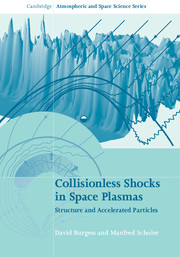Book contents
- Frontmatter
- Contents
- Preface
- Chapter 1 Shocks
- Chapter 2 Basic concepts
- Chapter 3 The quasi-perpendicular shock: macrostructure
- Chapter 4 The quasi-perpendicular shock: microstructure
- Chapter 5 The quasi-parallel shock
- Chapter 6 Diffusive shock acceleration
- Chapter 7 Coherent shock acceleration
- Chapter 8 Electron acceleration
- Chapter 9 Global and modified shocks
- Appendix Simulation techniques
- References
- Further reading
- Index
Chapter 3 - The quasi-perpendicular shock: macrostructure
Published online by Cambridge University Press: 05 August 2015
- Frontmatter
- Contents
- Preface
- Chapter 1 Shocks
- Chapter 2 Basic concepts
- Chapter 3 The quasi-perpendicular shock: macrostructure
- Chapter 4 The quasi-perpendicular shock: microstructure
- Chapter 5 The quasi-parallel shock
- Chapter 6 Diffusive shock acceleration
- Chapter 7 Coherent shock acceleration
- Chapter 8 Electron acceleration
- Chapter 9 Global and modified shocks
- Appendix Simulation techniques
- References
- Further reading
- Index
Summary
Introduction
Surveying the data from an Earth-orbiting spacecraft the differences between crossings of the quasi-parallel and quasi-perpendicular bow shock are usually easy to distinguish by their characteristic appearance in the magnetic field. Compared with the extended, turbulent transition of the quasi-parallel shock, the abrupt transition of the quasi-perpendicular shock resembles the idealized MHD shock discontinuity. The apparent simplicity of the quasi-perpendicular shock has produced a large body of observational work, which has focused on the average time-steady structure of the shock transition – the macrostructure of the shock. For most solar wind conditions the Mach number at the Earth's bow shock (and similarly for other solar system shocks) is strong enough to be greater than the critical Mach number found in MHD when resistivity is the dominant dissipation mechanism (see Section 2.4). At such supercritical shocks it is found that ion reflection is a characteristic feature, even though it is a consequence of the kinetics of particles in the shock fields. In this chapter we describe the macrostructure of supercritical quasi-perpendicular shocks, as found at the Earth's bow shock. This is by no means the complete picture, since, as well as the macrostructure, fluctuations are also present across the entire range of plasma time scales, from below the ion cyclotron frequency to above the electron plasma frequency. In Chapter 4 we discuss the microstructure of the quasi-perpendicular shock and its various causes.
The bow shock is observed when it passes over a spacecraft, since the spacecraft motion is generally much slower than that of the bow shock, in the Earth frame. The bow shock position varies in response to changes in the solar wind, and moves with a velocity up to several tens of kilometres per second, both outwards from the Earth and inwards towards the Earth. In a time series of data the bow shock is seen either as a transition from solar wind to magnetosheath (‘inward’ crossing) or from magnetosheath to solar wind (‘outward’ crossing). The quasi-perpendicular shock is characterized as ‘abrupt’, but what is actually observed in the time series will depend on the physical size of the transition, the sample cadence or averaging (i.e, the time resolution) of the data, and the bow shock speed relative to the spacecraft.
- Type
- Chapter
- Information
- Collisionless Shocks in Space PlasmasStructure and Accelerated Particles, pp. 69 - 113Publisher: Cambridge University PressPrint publication year: 2015



